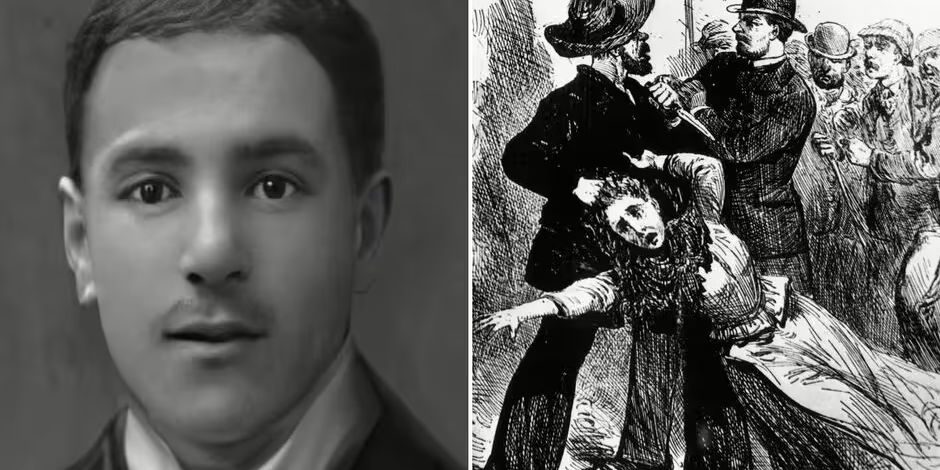Over a century after the gruesome reign of terror in the dark alleys of Whitechapel, the identity of Jack the Ripper may finally be unmasked. A recent forensic breakthrough has pointed to Aaron Kosminski, a Polish barber who was a prime suspect at the time, as the likely perpetrator of one of the world’s most infamous unsolved serial murder cases.

The Murders That Shook London
Between August and November of 1888, the Ripper brutally murdered at least five women—Mary Ann Nichols, Annie Chapman, Elizabeth Stride, Catherine Eddowes, and Mary Jane Kelly—leaving their mutilated bodies strewn across Whitechapel in a series of methodical, chillingly precise killings. The victims, all sex workers, were found with their throats slashed and their bodies horrifically disfigured, leading to speculation that the killer possessed surgical knowledge.
Despite widespread panic, hundreds of suspects, and an intense police investigation, the killer vanished into history, his identity remaining an enduring mystery—until now.
The DNA Breakthrough
In a significant development, forensic scientist Dr. Jari Louhelainen and author Russell Edwards claim to have identified the Ripper using modern DNA analysis. A bloodstained shawl, allegedly found near the body of Catherine Eddowes, was subjected to mitochondrial DNA testing. The results revealed a match between a descendant of Eddowes and a direct relative of Aaron Kosminski, a man long suspected but never conclusively proven to be the killer.
Kosminski, a Polish Jewish immigrant, arrived in London in the late 19th century and worked as a barber. He was placed under police surveillance at the time of the murders and later committed to an asylum in 1891, suffering from severe paranoid schizophrenia. Detectives at the time had their suspicions, but lack of concrete evidence meant he was never charged.

The Investigation: Clues, Letters, and Red Herrings
The investigation into Jack the Ripper’s identity was marred by false leads, unreliable witnesses, and taunting letters. The infamous “Dear Boss” letter, allegedly written by the killer, was sent to a London newspaper, signing off as “Jack the Ripper” for the first time. Another disturbing note, the “From Hell” letter, arrived with a small piece of a human kidney, allegedly from one of the victims. Were these real messages from the killer or elaborate hoaxes by journalists trying to sell papers?
Other Suspects and Theories
While Kosminski is now a prime suspect, others have been accused over the years, including Montague Druitt, a troubled barrister; Dr. Francis Tumblety, a quack doctor; and Walter Sickert, a famous artist obsessed with the Ripper murders. Some theories even suggest the killer could have been a Freemason conspiracy or a member of the Royal Family. These theories, while largely discredited, continue to fuel speculation and debate.
A City in Fear: The Aftermath of the Killings
The Whitechapel murders left a lasting mark on London’s East End, triggering widespread panic and leading to heightened police activity. Reports from the time describe a city gripped by fear, with residents too afraid to walk the streets alone at night. Newspaper headlines fueled speculation, and theories about the Ripper’s identity ranged from a rogue surgeon to a deranged aristocrat.
Despite Scotland Yard’s best efforts, the killings stopped as abruptly as they began. Some believe the killer may have died, been incarcerated, or fled the country. Others suggest he simply chose to disappear into obscurity, knowing that his reign of terror had forever imprinted itself on history.

The Victims’ Families Call for Justice
Following this revelation, families of the Ripper’s victims are now calling for an official inquest to formally acknowledge Kosminski as the serial killer responsible for the Whitechapel horrors.
“This is the closest we’ve ever come to identifying Jack the Ripper,” said one descendant of Mary Ann Nichols. “If the science is sound, then history should recognize who he was and finally bring closure to the victims’ families.”
While police records from the time suggest that Scotland Yard officers strongly suspected Kosminski, legal proceedings never advanced due to lack of admissible forensic evidence.
A Look at the Modern-Day Ripper Industry
Jack the Ripper’s story has transformed into a multimillion-dollar industry. Books, movies, walking tours, and conspiracy theories continue to capitalize on the public’s enduring fascination with the case. Whitechapel remains a popular tourist destination, where enthusiasts retrace the steps of a killer who was never caught.
The End of a 137-Year-Old Mystery?
If Kosminski is indeed the killer, the case of Jack the Ripper would finally be closed after 137 years. But forensic debates rage on. Some Ripperologists argue that the evidence remains circumstantial, and the case will never be fully resolved.
Meanwhile, Whitechapel’s dark history continues to haunt London’s streets. Tourists still flock to the Jack the Ripper walking tours, fascinated by the chilling legend of the faceless killer who evaded capture.
The Psychological Profile of a Killer
Experts have long debated the psychological makeup of Jack the Ripper. Some believe he was a highly intelligent but disturbed individual, while others argue he was a delusional madman driven by uncontrollable urges. Kosminski, diagnosed with paranoid schizophrenia, fits the profile of someone who might have exhibited violent tendencies without rational control.
His asylum records indicate hallucinations, delusions of persecution, and an aversion to hygiene, which were common symptoms of severe mental illness at the time. Did his deteriorating mental state eventually lead to the brutal murders? And if so, was he aware of his actions, or was he acting under uncontrollable impulses?
The Influence of Jack the Ripper in Popular Culture
The legacy of Jack the Ripper extends beyond the grim reality of his crimes. Over the years, he has been mythologized in books, films, and television, cementing his place as one of history’s most infamous criminals. From Hollywood thrillers to graphic novels, the Ripper’s image has been shaped and reshaped, often blending fact with fiction.
His story has inspired characters in literature, including Sherlock Holmes mysteries, and movies that portray him as anything from a sadistic aristocrat to a supernatural entity. The enduring fascination with Jack the Ripper underscores society’s obsession with unsolved mysteries and the darkest recesses of the human psyche.

10 Facts About Jack the Ripper
Here are 10 chilling facts about Jack the Ripper, one of history’s most infamous serial killers:
1. The Killer Was Never Caught
Despite an extensive police investigation, Jack the Ripper’s identity remains officially unsolved. Although modern DNA analysis suggests Aaron Kosminski, the case is still debated.
2. The “Canonical Five” Murders
The Ripper is officially linked to five murders—known as the Canonical Five—which took place between August and November 1888 in Whitechapel, London. Some believe he may have had more victims.
3. His Killings Were Brutally Mutilative
The Ripper didn’t just kill his victims—he mutilated their bodies in gruesome ways, often removing organs with surgical precision, leading to speculation that he had medical knowledge.
4. The Infamous Letters
Several letters were sent to the police and newspapers, allegedly from the killer. The “Dear Boss” letter was the first to use the name Jack the Ripper, while the “From Hell” letter contained a human kidney.
5. Over 100 Suspects
More than 100 suspects have been considered over the years, including Prince Albert Victor, Lewis Carroll (author of Alice in Wonderland), and Dr. Thomas Neill Cream.
6. The Murders Stopped Mysteriously
After Mary Jane Kelly’s brutal killing on November 9, 1888, the murders abruptly stopped, leading to theories that the Ripper was arrested, institutionalized, or dead.
7. The Case Sparked Fear and Panic
The Whitechapel murders led to widespread fear, riots, and media frenzy, with newspapers printing sensational headlines that fueled hysteria across London.
8. The ‘Jack the Ripper’ Industry
Today, Jack the Ripper has become a global phenomenon, inspiring books, movies, TV shows, and even walking tours in London that retrace his bloody path.
9. Police Investigations Were Heavily Criticized
The Metropolitan Police and Scotland Yard were widely criticized for their failure to capture the killer, with theories suggesting they were held back by social prejudices and corruption.
10. Modern Science Has Revived the Case
In 2019, forensic scientists tested DNA from a shawl allegedly found at a crime scene, linking Aaron Kosminski, a Polish barber, to the murders—though many experts still question the evidence.
Share Your Thoughts
Do you believe this latest DNA evidence is enough to name Aaron Kosminski as Jack the Ripper? Or does the case remain open? Comment below with your thoughts!







